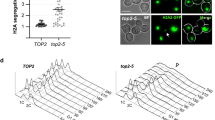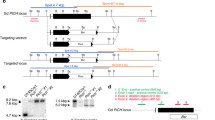Abstract
We found that 4′-demethylepipodophyllotoxinthenylidene-β-d-glucoside (VM-26; Teniposide), which specifically inhibits the enzyme DNA topoisomerase II, induces the formation of quadriradial chromosomes in Chinese hamster ovary cells. VM-26 traps topoisomerase II molecules when they are covalently integrated into DNA during their reaction. Quadriradial chromosomes are formed by reciprocal exchange of double-stranded DNA between single chromatids of two different chromosomes. Using synchronised cells, we found that they were formed after a single replication cycle in the presence of VM-26 at a low concentration (0.008μM), which does not affect DNA replication, and occurred in 50% of the mitotic cells at a concentration of 0.16 μM. They were also formed when VM-26 was present for only 1.5 h before mitosis, after the completion of S-phase DNA replication. Chromatids bearing a translocated segment of another chromatid, which were derived from recombined chromosomes, were observed in late metaphase cells. Segregation of the daughter genomes was defective in many mitotic cells, probably because chromatids with two or no centromeres and kinetochores, formed from chromosomes recombined between their centromeres, could not be segregated. In the light of evidence that topoisomerase II molecules covalently integrated in DNA are trapped and therefore more abundant in the presence of VM-26, and that this enzyme can effect recombination of double-stranded DNA in vitro, we interpret these observations as evidence that topoisomerase II can mediate chromosome recombination in vivo.
Similar content being viewed by others
References
Bae YS, Kawasaki I, Ikeda H, Liu LF (1988) Illegitimate recombination mediated by calf thymus DNA topoisomerase II in vitro. Proc Natl Acad Sci USA 85: 2076–2080
Chaganti RSK, Schonberg S, German J (1974) A manyfold increase in sister chromatid exchange in Bloom's syndrome lymphocytes. Proc Natl Acad Sci USA 71: 4508–4512
Charron M, Hancock R (1990a) DNA topoisomerase II is required for the formation of mitotic chromosomes in chinese hamster ovary cells: studies using the inhibitor VM-26 (4′-demethylepi-podophyllotoxinthenylidene-β-d-glucoside). Biochemistry 29: 9531–9537
Charron M, Hancock R (1990b) Roles of DNA topoisomerases I and II in DNA replication, mitotic chromosome formation, and recombination in mammalian cells. In: Zbarsky IB, Harris JR (eds) Nuclear structure and function. Plenum Press, London pp 405–411
Danks MK, Schmidt CA, Cirtain MC, Suttle DP, Beck WT (1988) Altered catalytic activity of and DNA cleavage by DNA topoisomerase II from human leukemic cells selected for resistance to VM-26. Biochemistry 27: 8861–8869
Deaven LL, Oka MSJ, Tobey RA (1978) Cell cycle specific chromosome damage following treatment of chinese hamster cells with 4′-[(9-acridinyl)-amino]-methanesulphon-m-anisidide. J Natl Cancer Inst 60: 1147–1152
DiNardo S, Voelkel K, Sternglanz R (1984) DNA topoisomerase II mutant of Saccharomyces cerevisiae: topoisomerase II is required for segregation of daughter molecules at the termination of DNA replication. Proc Natl Acad Sci USA 81: 2616–2620
Dresler SL, Frattini MG (1986) DNA replication and UV-induced DNA repair synthesis in human fibroblasts are much less sensitive than DNA polymerase a to inhibition by butylphenyl-deoxyguanosine triphosphate. Nucleic Acids Res 14: 7093–7102
Drlica K, Franco RJ (1988) Inhibitors of DNA topoisomerases. Biochemistry 27: 2253–2259
Filipski J (1983) Competitive inhibition of nicking-closing enzymes may explain some biological effects of DNA intercalators. FEBS Lett 159: 6–12
German J (1964) Cytological evidence for crossing-over in vitro in human lymphoid cells. Science 144: 300–302
Glisson B, Gupta R, Smallwood-Kentro S, Ross W (1986) Characterisation of acquired epipodopophyllotoxin resistance in a chinese hamster ovary cell line: loss of drug-stimulated DNA cleavage activity. Cancer Res 46: 1934–1938
Hancock R (1982) Topological organisation of interphase DNA: the nuclear matrix and other skeletal structures. Biol Cell 44: 201–212
Hancock R, Charron M, Lambert H, Lemieux M, Pankov R, Pépin N (1990) Iopoisomerase II as a target of antitumor drugs. In: Borowski E, Shugar D (eds) Molecular aspects of chemotherapy. Pergamon Press, London, pp 119–137
Huang CC, Hou Y, Wang JJ (1973) Effects of a new antitumor agent, epipodophyllotoxin, on growth and chromosomes in human hematopoietic cell lines. Cancer Res 33: 3123–3129
Huberman JA (1981) New views of the biochemistry of eucaryotic DNA replication revealed by aphidicolin, an unusual inhibitor of DNA polymerase α. Cell 23: 647–648
Ikeda H (1986) Bacteriophage T4 DNA topoisomerase II mediates illegitimate recombination in vitro. Proc Natl Acad Sci USA 79: 3724–3728
Liu LF (1989) DNA topoisomerase poisons as antitumor drugs. Annu Rev Biochem 58: 351–375
Osheroff N (1989) Effect of antineoplastic agents on the DNA cleavage/religation reaction of eukaryotic topoisomerase II: inhibition of DNA religation by etoposide. Biochemistry 28: 6157–6160
Pommier Y, Kerrigan D, Schwartz RE, Swack JA, McCurdy A (1986) Altered DNA topoisomerase II activity in chinese hamster cells resistant to topoisomerase II inhibitors. Cancer Res 46: 3075–3081
Potmesil M, Ross WE (1987) DNA topoisomerases in cancer chemotherapy. National Cancer Institute Monograph 3. NIH, Beltresda
Ralph RK, Schneider E (1987) DNA topoisomerases and anticancer drugs. In: Kon OL (ed) Integration and control of metabolic processes. Cambridge University Press, pp 373–388
Richter A, Strausfeld U, Knippers R (1987) Effects of VM26 (teniposide), a specific inhibitor of type II DNA topoisomerase, on SV 40 DNA replication in vitro. Nucleic Acids Res 15: 3455–3468
Snapka RM, Powelson MA, Strayer JM (1988) Swivelling and decatenation of replicating simian virus 40 genomes in vivo. Mol Cell Biol 8: 515–521
Sperry AO, Blasquez VC, Garrard WT (1988) Dysfunction of chromosomal loop attachment sites: illegitimate recombination linked to matrix association regions and topoisomerase II. Proc Natl Acad Sci USA 86: 5497–5501
Sullivan DM, Latham MD, Rowe TC, Ross WE (1989) Purification and characterisation of an altered topoisomerase II from a drug-resistant chinese hamster ovary cell line. Biochemistry 28: 5680–5687
Therman E, Kuhn EM (1981) Mitotic crossing-over and segregation in man. Hum Genet 59: 93–100
Uemura T, Ohkura H, Adachi Y, Morino K, Shiozaki K, Yanagida M (1987) DNA topoisomerase II is required for condensation and separation of mitotic chromosomes in S. pombe. Cell 50: 917–925
Yang L, Wold MS, Li JJ, Kelly TJ, Liu LF (1987) Roles of DNA topoisomerases in simian virus 40 DNA replication in vitro. Proc Natl Acad Sci USA 84: 950–954
Author information
Authors and Affiliations
Additional information
by M. Trendelenburg
Rights and permissions
About this article
Cite this article
Charron, M., Hancock, R. Chromosome recombination and defective genome segregation induced in Chinese hamster cells by the topoisomerase II inhibitor VM-26. Chromosoma 100, 97–102 (1991). https://doi.org/10.1007/BF00418242
Received:
Accepted:
Issue Date:
DOI: https://doi.org/10.1007/BF00418242




